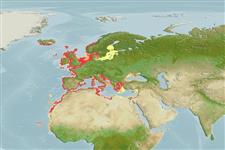Environment: milieu / climate zone / depth range / distribution range
экология
морской; пресноводный; солоноватоводный демерсальный; катадромный (Ref. 46888); пределы глубины 2 - 15 m (Ref. 130217). Subtropical; 65°N - 12°N, 24°W - 36°E
Eastern Atlantic: Scandinavia and Iceland (Ref. 4537) south to Senegal and Cape Verde. Also Mediterranean Sea; southwestern Black Sea (Ref. 2058).
Length at first maturity / Size / Вес / Возраст
Maturity: Lm 29.5 range ? - ? cm
Max length : 75.0 cm SL самец/пол неопределен; (Ref. 35388); common length : 32.0 cm SL самец/пол неопределен; (Ref. 7399); наибольший вес (опубликованные данные): 4.5 kg (Ref. 35388); наибольший возраст (опубликованны данные): 25 годы (Ref. 35388)
колючие лучи спинного плавника (общее число) : 5; членистые (мягкие) лучи спинного плавника (общее число) : 7 - 9; колючие лучи анального плавника: 3; членистые (мягкие) лучи анального плавника: 8 - 9.
Adults are found inshore in schools, frequently entering brackish lagoons and freshwater (Ref. 30578). They migrate occasionally tending to move northward in summer-time as temperatures rise. Females are larger than males (Ref. 59043). Adults feed mainly on benthic diatoms, epiphytic algae, small invertebrates and detritus (Ref. 2804), juveniles only feed on zooplankton (Ref. 59043). Oviparous (Ref. 205). Reproduction occurs in the sea during winter (Ref. 30578). Eggs and larvae pelagic. Utilized as a food fish (Ref. 4645).
Juveniles around 2.0 cm SL move to coastal lagoons and estuaries in April-June and return to sea in summer (Ref. 59043).
Thomson, J.M., 1986. Mugilidae. p. 344-349. In J. Daget, J.-P. Gosse and D.F.E. Thys van den Audenaerde (eds.) Check-list of the freshwater fishes of Africa (CLOFFA). ISNB, Brussels, MRAC; Tervuren; and ORSTOM, Paris. Vol. 2. (Ref. 3573)
Статус Красного Списка МСОП (Ref. 130435)
Угроза для людей
Harmless
Использование человеком
рыболовство: коммерческий; объект спортивного рыболовства: да; аквариум: общественные аквариумы
дополнительная информация
инструменты
Специальные отчеты
Скачать в формате XML
ресурсы в Интернет
Estimates based on models
Preferred temperature (Ref.
123201): 8.8 - 20.1, mean 11 °C (based on 420 cells).
Phylogenetic diversity index (Ref.
82804): PD
50 = 0.5005 [Uniqueness, from 0.5 = low to 2.0 = high].
Bayesian length-weight: a=0.00724 (0.00559 - 0.00939), b=3.11 (3.03 - 3.19), in cm total length, based on LWR estimates for this species (Ref.
93245).
Trophic level (Ref.
69278): 2.6 ±0.32 se; based on food items.
устойчивость к внешним воздействиям (Ref.
120179): средний (среднего размера), минимальное время удвоения популяции 1.4-4.4 года (K=0.12-0.17; tm=3; tmax=25).
Fishing Vulnerability (Ref.
59153): High vulnerability (63 of 100).
Climate Vulnerability (Ref.
125649): Moderate to high vulnerability (51 of 100).
Nutrients (Ref.
124155): Calcium = 39.2 [10.7, 335.3] mg/100g; Iron = 0.623 [0.303, 1.151] mg/100g; Protein = 17.9 [16.5, 19.5] %; Omega3 = 0.399 [0.166, 0.964] g/100g; Selenium = 9.58 [3.60, 24.88] μg/100g; VitaminA = 7.52 [2.12, 24.93] μg/100g; Zinc = 0.571 [0.342, 0.951] mg/100g (wet weight); based on
nutrient studies.
